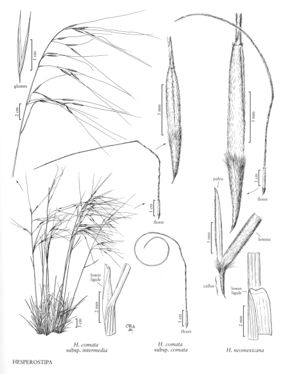Hesperostipa neomexicana
Culms 40-100 cm; lower nodes glabrous. Lower sheaths glabrous or puberulent, not ciliate; ligules of lower leaves 0.5-1 mm, thickly membranous, rounded; ligules of upper leaves to 3 mm, scarious, acute; blades 0.5-1 mm wide. Panicles 10-30 cm. Glumes subequal, 30-60 mm; florets 15-18 mm; calluses 4-5 mm; lemmas evenly pubescent, hairs shorter than 1 mm; awns 120-220 mm, first 2 segments hairy, hairs mostly 0.2-1 mm, terminal segment flexible, pilose, hairs 1-3 mm. 2n = 44.
Distribution
Okla., N.Mex., Tex., Utah, Wyo., Colo., Ariz., Nev.
Discussion
Hesperostipa neomexicana grows in grassland, oak, and pinyon pine associations, from 800-2400 m, usually in well-drained, rocky areas in the southwestern United States and adjacent Mexico. It is similar to H. comata subsp. comata, differing in its longer awn hairs and shorter ligules.
Selected References
None.
Lower Taxa
"decumbent" is not a number."prolonged" is not a number.
